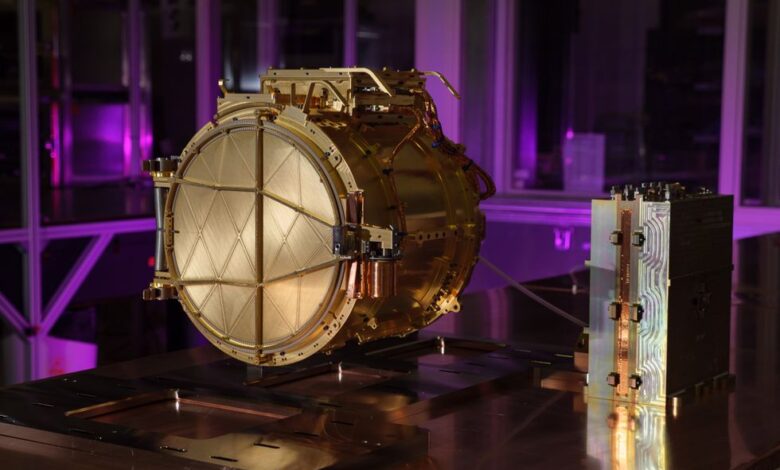9 Crucial Technologies for the Europa Clipper Mission

Europa is slightly smaller than Earth’s own moon and is one of the most fascinating and mysterious objects in the solar system. One of Jupiter’s four Galilean moons, Europa’s crust is a largely crater-free shell of ice, somewhere between tens and more than a hundred kilometers thick. Crisscrossed with streaks and fractures, and formed by unique processes, the ice hides beneath it a suspected ocean of uncertain depths and untold mysteries.
Europa is also shrouded in Jupiter’s unforgiving radiation belts. Thus, delving into the moon’s secrets—the very existence of which were hinted at by brief visits by both Voyager probes, as well as Galileo and Juno—requires a fair amount of ingenuity and resilience. NASA’s US $5 billion Europa Clipper mission is now en route, poised to tackle these challenges and address one of astrobiology’s most profound questions: Does Europa have the potential to harbor life?
The spacecraft launched on 14 October, after a short delay due to Hurricane Milton, some concerns over spacecraft transistors found to be failing at lower radiation doses than expected, and a multi-decade battle for political and budgetary backing. The spacecraft will reach Europa, some 700 million kilometers away, in 2030. Clipper will not orbit Europa, but make 49 flybys of the moon—more if the hardware holds out and the mission is extended—swinging in once every three weeks for approaches as close as 25 kilometers above the surface, and then heading back out beyond the intense, electronics-killing belts of radiation to prolong the mission.
Clipper is packed with a suite of nine instruments—imagers, spectrometers, magnetometers and radar—geared towards the key question of Europa’s habitability. Together, these instruments will build a multidimensional view of this icy jewel and, crucially, how it works. While not being able to detect life below the ice, the payloads will work in concert to determine whether or not life could develop there and elsewhere in the solar system.
SUrface Dust Analyzer (SUDA)
Europa’s lack of atmosphere means micrometeorites smack right into the moon’s surface. These small collisions send dust out into space. SUDA, a spectrometer, will scoop up this ejecta and, as these particles pass through metal mesh grids, determine the dust’s speed and trajectory, as well as its mass and composition.
By doing this, SUDA will tell researchers the composition of the ice and the salts present on Europa’s surface as well as clues to what lies below. Together with magnetic field measurements, this will help determine the depth of the ocean and the minerals present on its floor.
Beyond this, SUDA’s sensitivity will give far greater insight into what may be happening on Europa and whether it’s habitable.
“SUDA shines when it comes to identifying tiny traces of organics embedded in ice,” says Sascha Kempf, SUDA’s principal investigator and a planetary scientist at University of Colorado-Boulder. It is able to measure organic molecules at the parts per million level. SUDA’s sensitivity allows it to establish ratios of, for example, amino acids, and help determine if this would indicate a non-biological process or potentially an organism producing healthy amino acids.
MAss Spectrometer for Planetary EXploration/Europa (MASPEX)
Like SUDA, MASPEX is a spectrometer, but geared to analyzing the thin exosphere of gasses surrounding Europa and its chemical environment, seeking out elements necessary for life as we know it with unprecedented resolution. MASPEX would also be able to analyze material vented into space by suspected Europa water plumes, uncover signs of active geological processes or even detect potential biosignatures.
Europa Clipper Magnetometer (ECM)
ECM features a 8.5-meter-long boom which will detect and analyze any induced magnetic fields created by the interaction between Jupiter’s magnetic field and Europa’s subsurface ocean—if it is salty and producing electric currents. ECM aims to provide insights into the depth, salinity, and extent of the ocean beneath the ice, as well as if the ocean is interacting with the icy crust: A process likely necessary to create an environment conducive to life.
Plasma Instrument for Magnetic Sounding (PIMS)
PIMS is designed to measure the density and behavior of charged particles in Europa’s ionosphere and the surrounding plasma environment. Combined with magnetometer data from ECM, readings from PIMS will help determine how Europa’s subsurface ocean interacts with Jupiter’s magnetic field. By doing this, PIMS aims to ascertain the depth and conductivity of Europa’s ocean, as well as the thickness of the ice shell.
Radar for Europa Assessment and Sounding: Ocean to Near-surface (REASON)
REASON’s antennas will ping the surface with signals and catch the echoes with huge booms half the size of a basketball court, which will be deployed after liftoff. The reflected signals will allow the team to build a picture of Europa’s subsurface, determining the depth of the ice and where the theorized ocean begins—as well as any lakes in between—and help study Europa’s topography and composition.
“Planetary science has been an X-Y science,” says Don Blankenship, a research professor at the University of Texas Institute for Geophysics and principal investigator for REASON, referring to a two-dimensional coordinate system. “We’re bringing the vertical. We’re bringing the subsurface to planetary science.”
The payload will also help uncover evidence for the processes of any exchange between the ice and ocean below and the likelihood for chemistry that could support life.
“You’ve got reductants down below, hopefully, present in the ocean, and then oxidants at the surface. The organizing principle has to be the exchange. How does the surface get into the ocean? And how does the ocean get into the icy shell? And that’s why the radar is so important,” says Blankenship.
Mapping Imaging Spectrometer for Europa (MISE)
MISE will analyze infrared light reflected from Europa, measuring how different materials absorb and reflect sunlight at specific wavelengths and thus mapping water ice, salts, organics and minerals across the surface. Materials found near cracks and fractures will provide insight into how material may be exchanged between the surface and churning subsurface ocean.
Europa Ultraviolet Spectrograph (Europa-UVS)
Europa-UVS will collect ultraviolet light to study Europa’s surface and exosphere, and search for molecules of hydrogen, oxygen, hydroxide, and carbon dioxide. It will also hunt for evidence of plumes expelling material out into space.
Europa Thermal Emission Imaging System (E-THEMIS)
E-THEMIS will capture infrared wavelengths in fine spatial detail to map Europa’s surface temperatures, giving insight into night and day dynamics, identifying potential subsurface heat sources and indicators of geological activity and even eruptions of plumes or shifts in the icy crust.
Europa Imaging System (EIS)
EIS consists of one wide-angle and one narrow-angle camera, each with an eight-megapixel sensor spanning near-infrared, optical, and a small portion of ultraviolet frequencies. It will map Europa’s surface by capturing stereoscopic images at 100 meters per pixel, bringing new views and uncovering new terrain and features such as ridges, cracks, and potential active regions in unprecedented resolution.
“With Europa’s unique geology, we really want to understand the nature of the ice shell and the geologic processes acting within that ice shell,” says Elizabeth “Zibi” Turtle, a planetary scientist at Johns Hopkins Applied Physics Laboratory and EIS’ principal investigator.
REASON and EIS will combine to provide a data set to gain a three-dimensional understanding of the ice shell, with surface topography and subsurface imaging.
EIS will also look for plumes of water escaping the surface. Imaging the boundary between day and night on Europa could reveal plumes ejected from the nightside but with the ejecta catching sunlight high above the surface—similar to how plumes from rocket launches shortly after sunset produce “jellyfish” phenomena seen by viewers on Earth. “We have a plume search campaign throughout the tour at Jupiter,” says Turtle.
Along with producing a global and subsurface view of Europa, there are areas of particular interest. These include young, so-called chaos terrain regions of Europa, which may be signals of a churning interior, and dark irregular features known as macula.
“I think it is going to be just hugely informative and give us a spectacular, multidimensional, excellent picture of Europa and how it works,” says Turtle.
The focus is on habitability, in part because searching for life is not a task even easily defined. Given that the icy moon’s ocean is somewhat insulated from the outside, there is the possibility it could have fostered a possible second genesis within the solar system.
At the same time, If researchers are lucky, SUDA or MASPEX could detect life-like signatures. These could tease out amino and fatty acid patterns characteristic for organic matter. “I’m not saying that we hope to observe bacteria, but if there were one in such a particle, we could know it,” says Kempf, SUDA’s principal investigator. Such a detection would be nothing less than historic and set the stage for a followup lander mission.
Europa Clipper is scheduled to reach the Jupiter system in April 2030, via flybys of Mars and Earth. Then it will begin a whole new chapter in the search for life elsewhere in the solar system, illuminating the intrigues of Europa, but also providing a platform for understanding other icy moons such as Enceladus, Ganymede, and Triton.
IEEE Spectrum




